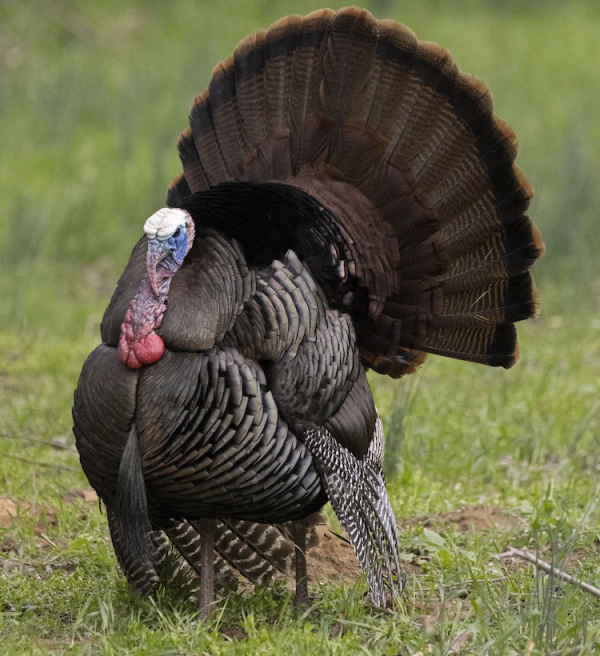
|
Ohio’s Wild turkey hunters checked 16,014 birds during the spring 2025 season which concluded on Sunday, June 1, according to the Ohio Department of Natural Resources (ODNR) Division of Wildlife. The total statewide harvest represents all turkeys checked from April 19 to June 1, along with the 1,740 birds taken during the two-day youth season, April 12-13.
During the 2024 spring season, the total number of turkeys checked was 15,535. The three-year average for the spring season (2022, 2023, and 2024) is 14,361.
The top 11 counties for wild turkeys taken in the 2025 season were Ashtabula (516), Monroe (462), Belmont (459), Guernsey (419), Muskingum (406), Trumbull (403), Tuscarawas (401), Carroll (396), Meigs (376), Columbiana (372), and Coshocton (372).
The season bag limit was one bearded bird. The Division of Wildlife issued 52,693 spring turkey permits for use during the spring 2025 hunting season. In 2024, the agency issued 51,530 spring turkey permits.
Adult male turkeys made up 81% of the final count with 12,904 birds taken. Following strong brood production summers in 2021, 2022, and 2023, biologists expected a high proportion of adult birds in the total harvest this spring. Following an above-average turkey brood in 2024, hunters checked 2,924 juvenile male turkeys in 2025, representing 18% of birds taken. Turkey hunters also checked 186 bearded female turkeys (hens) during the 2025 season.
Ohio’s spring turkey season is split into two zones to align with the timing of turkey nesting in those regions. The northeast zone includes Ashtabula, Cuyahoga, Geauga, Lake, and Trumbull counties. In 2025, 1,230 turkeys were checked in the northeast zone, while 14,784 birds were taken in the 83 counties that comprise the south zone.
Shotguns were the implement of choice for Ohio’s turkey hunters this spring, accounting for 98% of the total harvest (15,751 birds). The remaining 263 birds were taken with archery equipment.
Wild turkey research
Ohio’s wild turkey abundance peaked in the early 2000s. Since then, statewide turkey populations and spring harvest have fluctuated annually, but have been stable long-term. The Division of Wildlife began an in-depth study of wild turkey nesting and movement in 2023 to better understand and manage the state’s turkey population and expanded that study in 2024 and 2025. In the two preceding years, Ohio’s biologists affixed GPS transmitters to 151 hens in eastern and southwestern Ohio and gathered information on their movement, survival, and nest activity. This year, staff are following an additional 97 hens via GPS transmitters. The Division of Wildlife’s turkey study is in collaboration with researchers conducting similar studies in Maryland, New Jersey, and Pennsylvania.
Each summer, the Division of Wildlife collects information on young wild turkeys, called poults. Brood surveys in 2021, 2022, 2023, and 2024 showed results that benefitted Ohio’s wild turkey population numbers this spring. The statewide average poults per hen observed was 2.9 in 2024, 2.8 in 2023, 3.0 in 2022, and 3.1 in 2021, with a long-term average of 2.8. The brood survey is largely based on public reports. The Division of Wildlife encourages people to submit observations of wild turkeys during July and August at wildohio.gov.
Information gathered from the state’s varying turkey research projects will influence wild turkey management decisions in the coming years. This helps the Division of Wildlife structure science-based turkey hunting regulations, ensuring wild turkey success across Ohio for many more years.
The Division of Wildlife began an extensive program in the 1950s to restore wild turkeys to the Buckeye State after they were extirpated in the early 1900s. Ohio’s first modern day wild turkey hunting season opened in 1966 in nine counties, and hunters checked 12 birds. The total number of harvested turkeys topped 1,000 for the first time in 1984. Turkey hunting was opened statewide in 2000. The highest Ohio wild turkey harvest was in 2001, when hunters checked 26,156 birds.
The mission of the Division of Wildlife is to conserve and improve fish and wildlife resources and their habitats for sustainable use and appreciation by all. Visit wildohio.gov to find out more.??????
ODNR ensures a balance between wise use and protection of our natural resources for the benefit of all. Visit the ODNR website at ohiodnr.gov.?